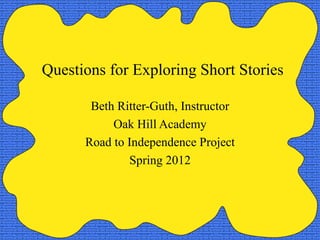
Short Story Lecture Notes
- 1. Questions for Exploring Short Stories Beth Ritter-Guth, Instructor Oak Hill Academy Road to Independence Project Spring 2012
- 2. Mode • Is the story: – Comic – Pathetic – Tragic – Satiric – Elegiac – Didactic
- 3. Narrator • Who is the narrator? • Is the narrator also a character? • What role does the narrator play in the development of the plot? • Do we trust the narrator?
- 4. Background • How does the story start? • What happened before the story started? • Where does the reader “land” in the story? • How do we learn this background? • Is the delivery of this background important to the plot of the story?
- 5. Characters • Who are the main characters? • How are they introduced in the story? • When are they introduced? • What do we know about these characters? • What do we need to know about them? • Do they fit any archetypal patterns?
- 6. Character and Setting • What time period is the story set? • Do the characters behave according to the standards of time and location? • What do we need to understand about the time period, customs, language, mores, habits, and traditions of the culture or time period?
- 7. Characterization? • How are the major characters drawn? What are their major strengths? Weaknesses? Are they active? Passive? • How to the characters function in relationship to one another? • How do the minor characters work with the major characters? • Do we trust the characters? Why or why not?
- 8. Action, Speech, Ideas • How to characters present their ideas? • How is speech crafted to provide characterization? • Which is more important to the character - actions or speech? • Does the reader “get inside the head of” any character? • Do the characters change (for better or worse) during the story?
- 9. Setting • How does the author address setting? • Is the setting described in full or is it implied? • What role does the setting play in the plot/action of the story. • How does the setting establish mood? • Does the setting impact character development?
- 10. Plot • Is the plot of the story the most meaningful part of the story? If not, what is? • Is there anything missing in the plot? Is this element missing on purpose? • Are there any inconsistencies in the plot? Are these intentional? • How does memory play a role in the development of the plot? Do we trust these memories?
- 11. Organization of Plot • Is the story organized thematically or chronologically? • Would the outcome be different if the events happened differently? • What are the motivations of the major and minor characters?
- 12. Theme • Is this story didactic? • What is the point of the story - to inform, persuade, or entertain? • How does the plot establish the theme? • How do the characters function in relationship to the theme? • What value statements are implied by the theme?
- 13. Symbols • Are symbols used in the story? • Do the characters recognize the symbols, or are the symbols used for the benefit of the reader only? • Do these symbols add meaning? Why, or why not? • Are there major and minor symbols? • Are the symbols archetypal?
- 14. Reality and Believability • Is this story believable or fantastical? • Does the story need to be believable to achieve the overall effect or impact of the story? • How does the plot function in believability? • Are the characters believable? • Is the setting realistic? Does it need to be realistic?
- 15. Critical Theory • How would a Feminist react to this story? • How would a New Critic react to this story? • How would a Deconstructionist react to this story? • How would a Psychoanalytic critic react to this story? • How would an Ecocritic react to the story?
